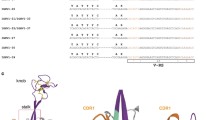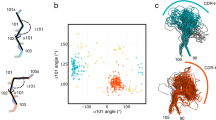Abstract
RANDOM association of VL and VH repertoires contributes considerably to antibody diversity1. The diversity and the affinity are then increased by hypermutation in B cells located in germinal centres2. Except in the case of 'heavy chain' disease3, naturally occurring heavy-chain antibodies have not been described, although antigen binding has been demonstrated for separated heavy chains4 or cloned VH domains5. Here we investigate the presence of considerable amounts of IgG-like material of Mr 100K in the serum of the camel (Camelus dromedarius)6. These molecules are composed of heavy-chain dimers and are devoid of light chains, but nevertheless have an extensive antigen-binding repertoire, a finding that calls into question the role of light chains in the camel. Camel heavy-chain IgGs lack CH1, which in one IgG class might be structurally replaced by an extended hinge. Heavy-chain IgGs are a feature of all camelids. These findings open new perspectives in the engineering of antibodies.
Similar content being viewed by others
References
Tonegawa, S. Nature 302, 575–581 (1983).
Jacob, J., Kelsoe, G., Rajewski, K. & Weiss, U. Nature 354, 389–392 (1991).
Fleischman, J. B., Pain, R. H. & Porter, R. R. Arch. Biochem. Biophys. Suppl. 1, 174–180 (1962).
Utsumi, S. & Karush, F. Biochemistry 3, 1329–1338 (1964).
Ward, E. S., Güssow, D., Griffiths, A.D., Jones, P. T. & Winter, G. Nature 341, 544–546 (1989).
Ungar-Waron, H., Eliase, E., Gluckman, A. & Trainin, Z. Isr. J. vet. Med. 43, 198–203 (1987).
Bajyana Songa, E. & Hamers, R. Ann. Soc. Belge Méd. Trop. 68, 233–240 (1988).
Seligmann, M., Mihaesco, E., Preud'homme, J.-L., Danon, F. & Brouet, J.-C. Immun. Rev. 48, 145–167 (1979).
Traunecker, A., Schneider, J., Kiefer, H. & Karjalaien, K. Nature 339, 68–70 (1989).
Henderschot, L. M., Bole, D., Köhler, G. & Kearney, J. F. J. Cell Biol. 104, 761–767 (1987).
Henderschot, L. M. J. Cell Biol. 111, 829–837 (1990).
Roholt, O., Onoue, K. & Pressman, D. Proc. natn. Acad. Sci. U.S.A. 51, 173–178 (1964).
Chothia, C., Novotny, J., Bruccoleri, R. & Karplus, M. J. molec. Biol. 186, 651–663 (1985).
Kabat, E. A., Wu, T. T., Reid-Miller, M., Perry, H. M. & Gottesman, K. S. Sequences of Proteins of Immunological Interest 511 (US Dept of Health and Human Services, US Public Health Service, NIH, Bethesda, 1987).
Jackson, T., Morris, B. A. & Sanders, P. G. Molec. Immun. 29, 667–676 (1992).
Poljak, R. J. et al. Proc. natn. Acad. Sci. U.S.A. 70, 3305–3310 (1973).
Dangl, J. L., et al. EMBO J. 7, 1989–1994 (1988).
Schneider, W. P. et al. Proc. natn. Acad. Sci. U.S.A. 85, 2509–2513 (1988).
Evans, J. S. et al. FEBS Lett. 208, 211–216 (1986).
Roditi, I. et al. J. Cell Biol. 108, 737–746 (1989).
Dunnick, W., Rabbits, T. H. & Milstein, C. Nucleic Acids Res. 8, 1475–1484 (1980).
Bülow, R., Nonnengässer, C. & Overath, P. Molec. Biochem. Parasitol. 32, 85–92 (1989).
Sambrook, J., Fritsch, E. F. & Maniatis, T. Molecular Cloning: A Laboratory Manual 2nd edn (Cold Spring Harbor Laboratory Press, New York, 1989).
Sastry, L. et al. Proc. natn. Acad. Sci. U.S.A. 86, 5728–5732 (1989).
Sanger, F., Nicklen, S. & Coulson, A. R. Proc. natn. Acad. Sci. U.S.A. 74, 5463–5467 (1977).
Klein, J. Immunology (Blackwell Scientific, London, 1990).
Author information
Authors and Affiliations
Rights and permissions
About this article
Cite this article
Hamers-Casterman, C., Atarhouch, T., Muyldermans, S. et al. Naturally occurring antibodies devoid of light chains. Nature 363, 446–448 (1993). https://doi.org/10.1038/363446a0
Received:
Accepted:
Issue Date:
DOI: https://doi.org/10.1038/363446a0
- Springer Nature Limited
This article is cited by
-
NanoBERTa-ASP: predicting nanobody paratope based on a pretrained RoBERTa model
BMC Bioinformatics (2024)
-
Assessing antibody and nanobody nativeness for hit selection and humanization with AbNatiV
Nature Machine Intelligence (2024)
-
Anti-CTLA-4 nanobody as a promising approach in cancer immunotherapy
Cell Death & Disease (2024)
-
EVOCA™, the first biofungicide developed by Biotalys’ AGROBODY Foundry™ platform
Journal of Plant Diseases and Protection (2024)
-
Next-Generation Anti-TNFα Agents: The Example of Ozoralizumab
BioDrugs (2024)





